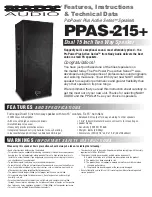
Proceedings of the Institute of Acoustics
When a response is flat in a broadband sense, the medians calculated over various (large) fre-
quency bands are similar. In this study, differences of median sound pressure between subbands
are taken to indicate that broadband tonal balance of a response is not flat. An improvement in the
broadband tonal balance due to equalisation is then indicated by a reduction of median value differ-
ences.
Table 11. Frequency band definitions the statistical data analysis;
f
LF
is the frequency of the lower –
3 dB limit of the frequency range.
Frequency Range Limit
Bandwidth Name
Low
High
Broadband
f
LF
15 kHz
LF
f
LF
400 Hz
MF
400 Hz
3.5 kHz
HF
3.5 kHz
15 kHz
4.2
Example of Statistical Data Analysis
Figure 1 shows an example where room response control settings are calculated according to the
optimisation algorithm. The equalisation target is a flat magnitude response (straight line at 0dB
level). The in-situ frequency response of the loudspeaker was recorded before equalisation, i.e.
when all the room response controls were set to their default position, which has no effect to the re-
sponse. The appropriate room response control settings were calculated using the optimisation al-
gorithm, applied to the loudspeaker and the corrected in-situ frequency response plotted. The loud-
speaker’s passband (triangles) and the frequency band of equalisation (crosses) are indicated on
the graphical output. The proposed room response control settings are shown and the effect of
these settings is visualised in the response plot. The treble tilt, midrange level and bass tilt controls
have been set. The equalisation corrects the low frequency alignment and improves the linearity
across the whole passband. The optimised result is displayed in green and dark grey boxes. The
green boxes are room response controls that should be set on the loudspeaker. The light grey
boxes are room response controls that are not present on the loudspeaker. Also displayed in this
area is the error function, which is an RMS of the optimised frequency response pass band.
Figure 2 shows a statistical analysis of the same loudspeaker presented in graphical form. The up-
per three plots were calculated before equalisation and the lower three plots after equalisation. The
plots display the values of percentiles in the magnitude value distribution (box plot), the histogram of
values and the fit of the magnitude values to normal distribution before and after equalisation.
These plots clearly show that the deviation in magnitude data has been reduced. This is illustrated
by the reduced range in the box plot and the value histogram, as well as a better fit to a normal dis-
tribution in the normal probability plot.
Two detailed case studies can be seen in
38
. Responses before an after equalisation are shown to-
gether with room acoustic analysis to show that the algorithm performs well, even in widely varying
conditions.



































